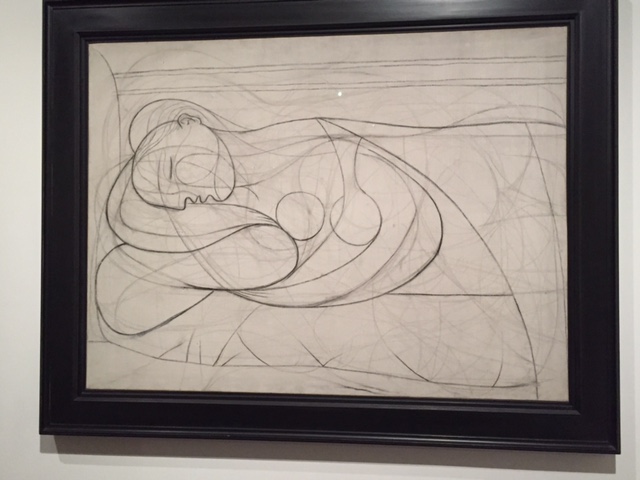Last weekend, I viewed the “Visiting Masterpieces: Pairing Picasso” exhibit, which is available until June 26, 2016, in the Lee Gallery at the Museum of Fine Arts in Boston, Massachusetts. The exhibit features five paired works that artist Pablo Picasso (1881-1973) created at the height of his career between the 1900s and the 1960s. Upon my visit, I entered the intimate yet inviting gallery space, and was immediately greeted by his paintings, which are mounted on panels placed at various angles, perhaps to mimic the asymmetrical angles found in his Cubist paintings. Track lighting evenly illuminates the white panels and paintings, and two benches are strategically placed in the middle of the room, inviting sustained contemplation of his works of art. The exhibit does not feature too many or too few works, making it just small enough for a shorter visit, and just large enough for viewers to extensively and deeply analyze the art.
The layout of the gallery ties into its goal, as elucidated by the exhibit’s curator, Katie Hanson: to give viewers the unique experience of contemplating groups of paintings together.[1] Grouping the paintings together teaches viewers about the different ways Picasso treated the human form, and highlights the fact that Picasso never considered any of his works “finished.” Instead, Picasso wanted his viewers to consider his works as unfinished parts of a unified whole; as he stated, “I don’t want to spoil the first freshness of my work…There would never be a ‘finished’ canvas, but just the different ‘states’ of a single painting.”[2] Therefore, treating the paintings as a series unto themselves seems fitting for the intentions of the artist.
Keeping Picasso’s philosophy and the curator’s goals in mind, I was immediately captivated by the first series of works that I spent time with. This is a series of three, the subject of which is Marie-Thérèse Walter (1909-1977), Picasso’s muse and lover. The first one, Sleeping Nude (Marie-Thérèse), a charcoal drawing of Walter sketched in 1932, seems fitting as the first “state” of his three works. The canvas is almost entirely unfinished: Walter’s body seems to spiral away into a series of abstracted curves and lines, except for a few more defined shapes which stand in for her facial features, face, chest, and arms. A few more sparse lines and the angle of her body suggest that she is lying down, but the rest of the setting is left entirely up to the imagination.

Pablo Picasso, Sleeping Nude (Marie-Thérèse), 1932. Charcoal on canvas. Private Collection.
As Picasso would suggest, Walter’s bodily form progresses into the next canvas (Head of a Woman, Portrait of Marie-Thérèse Walter, 1934), which is treated completely differently than the charcoal drawing. Picasso uses flat, wide brushstrokes to portray the sitter’s features and the background, reducing her face and shoulders to the simplest of shapes. Picasso’s Cubist style has always captivated me, especially as a way to portray a subject’s unique and varied forms on a mere two-dimensional canvas.

Pablo Picasso, Head of a Woman, Portrait of Marie-Therese Walter, 1934. Oil on canvas. Isabelle and Scott Black Collection.
The “series” ends in a painting entitled The Rescue (1932). It depicts a near-death experience Walter had while swimming, using cool colors such as blues, purples, and greens to portray the surrounding water and to encapsulate the horror of the event. Picasso again reduces the figures’ bodies to different shapes and lines that indicate the female form, and portrays the figures at different angles to suggest Walter’s movement out of the water as she is rescued from drowning. Picasso also paints narcissus flowers, tiny flecks of white that evoke the Greek myth of Narcissus, a tale that uses water as a metaphor for the imminence of death. I have always loved the narratives that Picasso creates in his paintings, which leave much up to the imagination, while giving tiny iconographic clues that situate the viewer in a specific time and place.

Pablo Picasso, The Rescue, 1932. Oil on canvas. Fondation Beyeler, Reihen/Basel, Beyeler Collection.
I thoroughly enjoyed this exhibit, because it encouraged me to view Picasso’s works as an unfinished series while building upon my prior knowledge of the artist. This exhibit gave me a different art-historical lens, and helped me to realize how much beauty lies in the unfinished.
—————-
[1] Museum label for exhibit, Visiting Masterpieces: Pairing Picasso, Boston, Museum of Fine Arts, 13 February 2016 – 26 June 2016.
[2] Museum label for artist, Sleeping Nude (Marie-Therese), 1932, and Head of a Woman, Portrait of Marie-Therese Walter, 1934, Boston, Museum of Fine Arts, 13 February 2016 – 26 June 2016.
